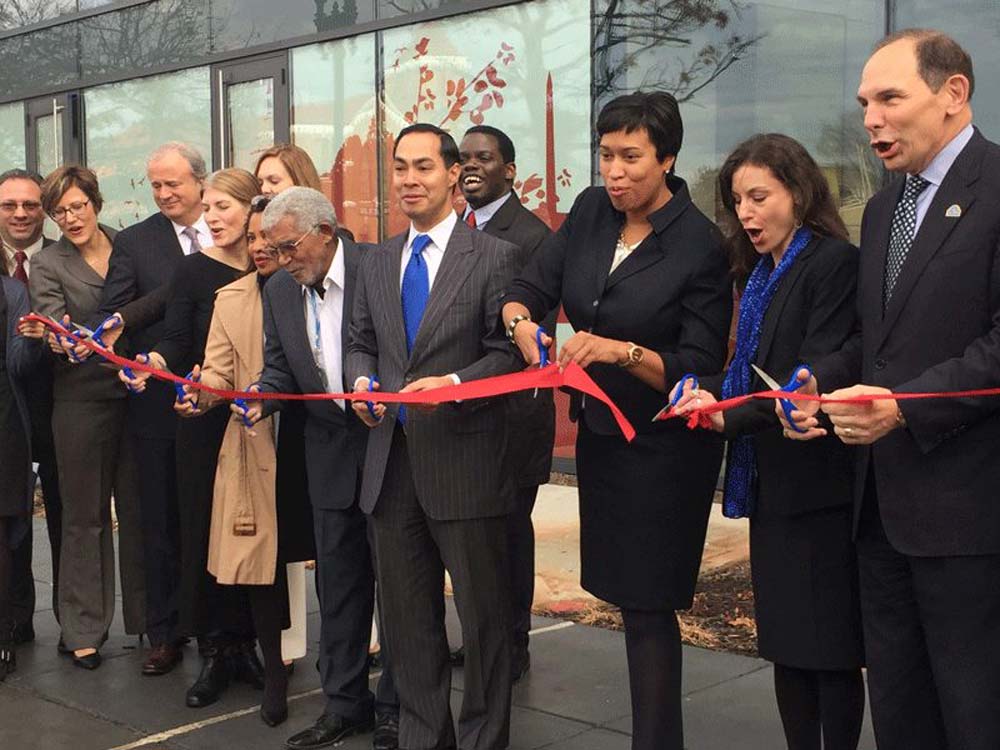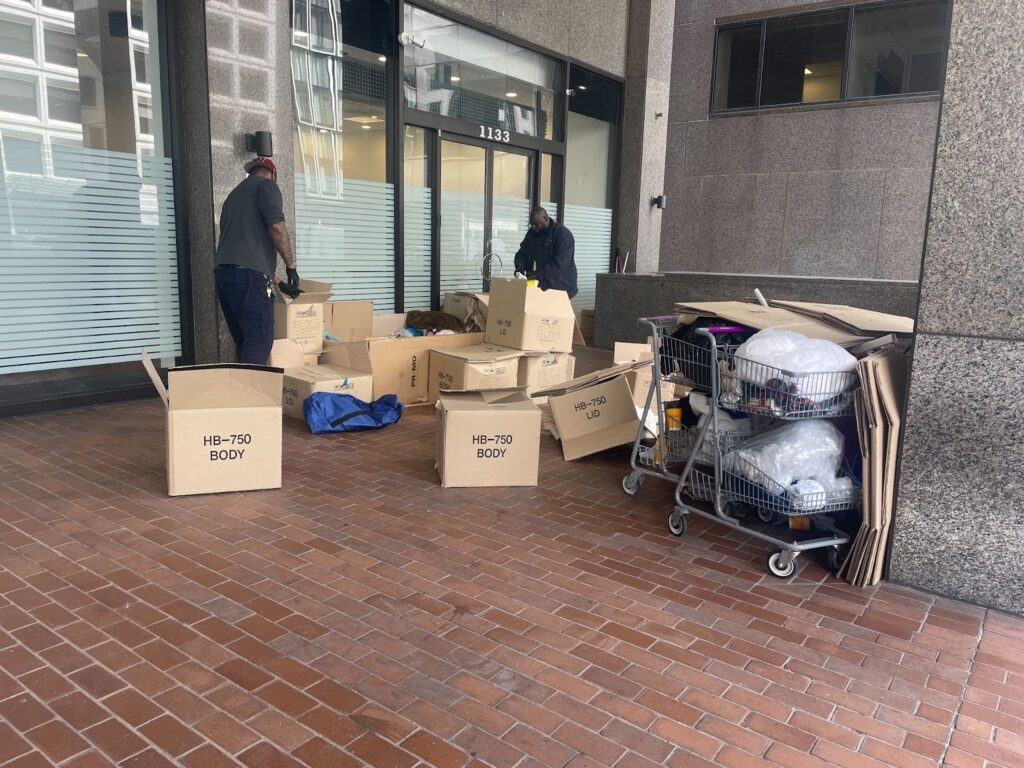Clifford Rowe is a veteran of the 101st Airborne Division who served during the Bay of Pigs invasion and played in Elvis Presley’s band. Now, thanks to new housing for homeless veterans, Rowe has his own home for the first time in 12 years.
On Jan. 12, the John and Jill Ker Conway Residence officially opened, providing homeless veterans with permanent supportive housing as well as affordable housing for Washingtonians.
Mayor Muriel Bowser, U.S. Department of Housing and Urban Development Secretary Julián Castro and U.S. Secretary of Veterans Affairs Robert A. McDonald together cut the ribbon on the new 14-story building located ten blocks away from the Capitol.
Bowser touted the residence as a blueprint for homelessness work in other cities. “It is a model for how a prosperous nation and a prosperous city must and should serve the people who, in the words of one of my constituents, have served their country more than most,” she said.
“In a city as prosperous as ours, no one should have to sleep on our streets or in our shelters,” said Laura Zeilinger, director of the D.C. Department of Human Services. She said that 1100 homeless veterans have exited homelessness in the last 2 years.
The building includes 124 units: permanent supportive housing for 60 formerly homeless veterans; 17 for consumers of D.C. Department of Behavioral Health services and 47 for individuals making no more than 60 percent of Area Median Income. Veterans Affairs case managers work in the building to connect veterans to health and employment services.
Rowe moved into his unit two days before Christmas, after anxiously awaiting his new home throughout the fall. While he experienced homelessness, he slept anywhere from friends’ couches to cars to park benches, where he slept with a bungee cord attached to his two guitars so that if someone pulled one he would wake up.
At 76 years old, he relishes the ability to relax in his recliner in his own apartment, enjoying the scenic view of the Capitol building and the Veterans Affairs hospital. The efficiency units include a bedroom, bathroom, living space and small kitchenette, with a more extensive common kitchen area with ovens. The rooms are small in order to encourage residents to spend time together and build community, according to Jake McGuire, Community Solutions’ director of communications.
“Living at the Conway Residence is a dream to me. When I look out the window on the 10th floor, it feels like I’m in heaven looking down,” Rowe said. “But my favorite thing about it isn’t the view or even the neighborhood, it’s that it’s mine.”
Tenants were assigned to the Conway Residence based on an assessment of their vulnerability, using the “housing first” model of prioritizing permanent housing and then providing supportive services as needed.
HUD Secretary Julián Castro contrasted the celebration of the building’s opening to the tragedy of the death of Joseph Watkins, a man experiencing homelessness who died of treatable illnesses on a D.C. park bench. He was one of the first homeless people to die in 2017.
“We know that any death is tragic, but we know it’s more so because he had no place to call home,” Castro said. “We know that once people get into housing their health does improve, that there is hope.”
A joint project of the nonprofit Community Solutions and the property development firm McCormack Baron Salazar, Inc, the building required collaboration from over 50 groups and included funding from more than 10 sources. According to McGuire, the building’s design is meant to be inspiring and beautiful, bucking the trend of affordable housing that is purely functional. Sorg Architects designed the residences to be made of sustainable materials.
The building was named for historian and Pulitzer-prize winning memoirist Jill Ker Conway — former chair of the Community Solutions board of directors — and her late husband, a World War II veteran. Jill Ker Conway’s father, William Innes Ker, was wounded in World War I and died when she was 15. “Military service may end, but the effects, to varying degrees, last a life-time,” said Chris Goldie, Conway’s nephew. “And all too often civilian memories are short.”
Glenn Jones is another resident who has already moved into his home in the building. Originally from Brooklyn, he served as a Marine in the Special Forces between 1974 and 1979 in Vietnam. He looks forward to the independence of his new home, including choosing when he eats and sleeps. “I’m soaking it all in,” he said happily. “I love it, my own place.”
Billy Williams, who will move in soon, echoes Jones’ eager anticipation of having a place to himself. “First thing I’m going to do is soak in the bathtub for two hours. I’m going to do that for a week, once a day, maybe twice a day. And get some much-needed sleep,” he said.
Williams, like Rowe, is a musician. “I just know that I like it and it makes me happy,” he said, adding that sometimes the music comes to him, he hears the sounds. Sometimes he hears voices too. He doesn’t take medicine for it, however. He says when he did, it made him disoriented. He was prescribed Seroquel, an antipsychotic used to treat schizophrenia and also sometimes used as part of treatment for bipolar disorder and/or depression.
Williams especially valued that at 1005 North Capitol St, there was only a one-time $300 pet fee, due to the circumstances under which he most recently became homeless. “I was renting a room for close to a year and a half, when one day I received a letter saying there were no pets allowed. But I’m not getting rid of my dog. I’ll dance with Satan first.”
He had received a second housing offer two days after learning about the Conway Residence on North Capital. This offer was for a location at 21st St and Maryland Avenue. The building was beautiful and Williams had even worked on some of the drywall there during its remodeling. However, to Williams, “two blocks in any direction is chaos, drugs.”
This was a concern for Williams regarding most of the apartments he had been shown during his search for housing. “Most of the apartments they showed me were across the river. Now, I’m not prejudiced or anything, but most of the White cats I’ve been out here with — drank with, slept next to — they put them up in buildings around here brand new out of the ground,” he said. “And you’re going to put me somewhere I have to fight to get the groceries in the house?” Williams explained that he wasn’t judging people struggling with addiction, just speaking from experience having overcome his own drug abuse issues.
“Not everybody wants to go into a shelter. I went. I caught crabs up in the shelter. And its hard to sleep next to someone who doesn’t want to take a bath,” he said.
Williams decided to turn down the second offer. Then the Sept. 17 opening/move-in day he had been told was pushed back to Oct. 23, then December and now January. Like Rowe, he waited impatiently throughout the fall, and hopes that soon he will move in.
Forty-six of the veterans have moved into the Conway Residence as of Jan. 25, and there are plans to fill the remaining veteran units by the end of January.









